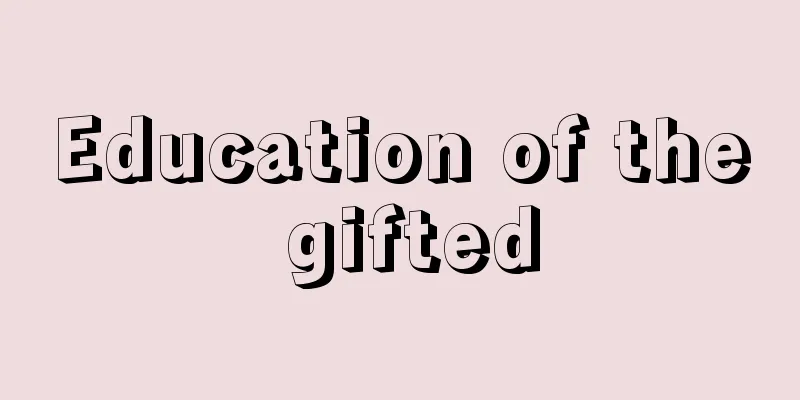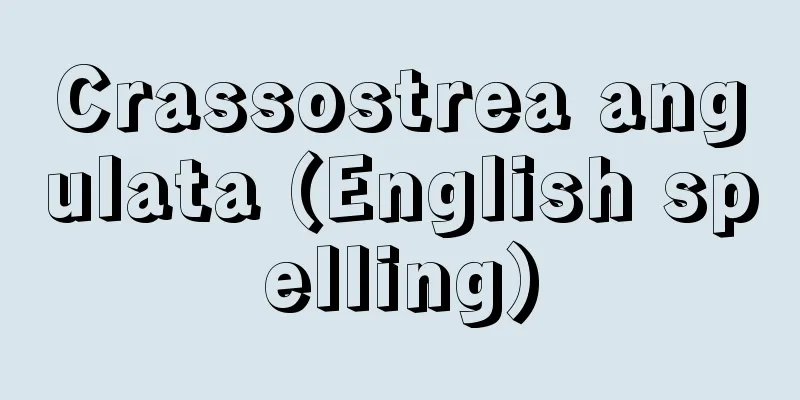Education of the gifted

|
It is a special education that aims to find people with particularly outstanding talents (especially intellectual and mental abilities, so-called intelligence) at an early stage and develop those talents to the fullest. It can therefore be considered a type of "education of the talented," but it is usually used in areas of special skills such as art and sports. There is no set definition of the gifted, but the most widely used standard is the intelligence quotient (IQ) measured by an intelligence test developed by French psychologist Alfred Binet to identify people with intellectual disabilities. IQ is calculated from the ratio of mental age to chronological age. An IQ of 90 to 110 is usually considered normal, which accounts for about 50 to 70% of the population, and it is said that people with high and low IQs are distributed around this center along a normal distribution curve. Of these, an IQ of 110 to 130 is called excellent (about 20 to 25%), and an IQ of 130 or more is called gifted (3%), and some scholars call those with an IQ of 140 or more (1% of the total) geniuses. However, since the word genius is often used to describe special talents such as those in the arts, it is common to use the term gifted to encompass all. British geneticist Galton and American psychologist Terman argued that IQ does not change with age and is relatively constant, and that people with high intelligence are superior in all aspects, not just intellectually. However, this argument has since been subject to much criticism, and it has come to be said that intelligence does not necessarily go hand in hand with creativity, artistic talent, or the ability to handle human relationships. For this reason, intelligence deviation scores have often been used instead of IQ. However, in Japan, deviation scores are often used to describe academic ability for entrance exams, and an education system based on deviation scores is considered to be the root of all evil. [Michiya Shinbori] IssuesToday, with the progress of deindustrialization, the importance of advanced knowledge, information, science, and technology is increasing. In Japan, the development of brain-intensive industries and advanced culture is strongly required from the perspective of international competitiveness, and there is a strong awareness in industry and academia that creativity determines the future of the country. The government also emphasizes responding to the IT revolution and becoming a science and technology-based nation, and gifted education has been proposed by related councils. However, in education after World War II, equality, uniformity, and uniformity have become deeply rooted tendencies, and gifted education has been considered taboo under the names of "discrimination/selection" and "elitism." This is due to reflections on the dual-track education system before World War II and the recognition of various negative effects resulting from the postwar emphasis on exam-winning students (so-called deviation-score gifted students). Furthermore, the problem is that there is no scientific or public consensus on the definition and identification of gifted students, or the methods, content, and purpose of gifted education. Furthermore, the distinction between gifted education and genius education, talent education, elite education, etc. is not clear. For this reason, early development of talent and education in so-called elite schools, such as Japan's high schools (old system) before World War II, Britain's "Oxbridge" (Oxford University and Cambridge University), and France's Grandes Écoles, are sometimes thought of as a type of gifted education. [Michiya Shinbori] Main types In ancient times, Mencius considered obtaining and educating the most gifted people in the world to be one of the "three joys of a gentleman," and Plato advocated philosophical education. If we interpret gifted education in the broadest terms, many countries have a dual-track school system with schools for the nobility, rulers, and elites, and schools for the common people, and the former schools implemented a type of gifted education from an early stage. Later, basic education was made common to all citizens, and from this, gifted students were selected through many rigorous methods, including entrance exams, and these students were given special education in higher education. However, gifted education in the narrow sense only began to be taken up in schools in the second half of the 19th century. Today, the main forms it takes are: [Michiya Shinbori] "Gifted Education" edited by Shimizu Yoshihiro and Mukaibo Takashi (1969, Daiichi Hoki Publishing)" ▽ "Ability, Aptitude, Selection and Education" edited by Fujinaga Tamotsu and Aso Makoto (1975, Daiichi Hoki Publishing)" ▽ "Genius" by Miyagi Otoya (Iwanami Shinsho)" ▽ "Intelligence" by Kamide Hiroyuki and Ito Ryuji (1972, Yuhikaku)" ▽ "Types of Intelligence" by Inoue Toshiaki (1994, Toki Shobo)" [Reference items] | | | | | | | | | | |Source: Shogakukan Encyclopedia Nipponica About Encyclopedia Nipponica Information | Legend |
|
とくに優秀な才能(なかでも知的、精神的な能力、いわゆる知能)の所有者を早期に発見し、その才能を最大限に開発することを目ざす特別な教育をいう。したがって才能教育education of the talentedの一種とも考えられるが、ふつう才能教育は、芸術やスポーツなど特技領域について用いられる。英才の定義はかならずしも一定しないが、もっとも広く用いられる基準は知的障害者鑑別用にフランスの心理学者アルフレッド・ビネーが開発した知能検査によって測定される知能指数(IQ)である。IQは精神年齢と暦年齢との比から算出される。普通、IQ90~110が正常と考えられ、これに人口の約50~70%が入るが、これを中心としてIQの高い者と低い者とが正常分布曲線を描いて分布するとされる。そのうちIQ110~130を優秀(約20~25%)、130以上を英才(3%)とよび、なかでもとくに優れた者(140以上。1%)を天才とよぶ学者もいる。ただし天才という語は往々にして芸術など特殊才能について使用される習慣があるので、英才の名で包括するのが普通である。イギリスの遺伝学者ゴルトンやアメリカの心理学者ターマンらは、IQは年齢とともに変化せず、比較的恒常性をもつとし、また高い知能の所有者は知的にだけでなく、あらゆる面で優れていると主張したが、その後、この主張には多くの批判が加えられ、知能は、創造性、芸術的才能、人間関係処理能力などとかならずしも並行しないとされるようになった。そのため、IQにかえて、知能偏差値が用いられることが多くなった。ただし、わが国では偏差値は受験用学力について用いられることが多く、偏差値を基にした教育制度は諸悪の根源とされている。 [新堀通也] 問題点今日、脱工業化の進展によってますます高度な知識や情報、科学や技術の重要性が高まりつつあり、とくにわが国では頭脳集約産業や高度な文化の発達が国際競争力の観点からも強く要請され、産業界や学界などでは創造性が国の将来を左右するという認識が強い。政府もIT革命への対応、科学技術立国などを強調し、英才教育が関係諸審議会によって提案されている。ところが第二次世界大戦後の教育では、平等と画一、横並びの一斉主義が根強い傾向として定着し、英才教育は「差別・選別」「エリート主義」などの名のもとにタブー視されてきた。そこには第二次世界大戦前の複線型教育制度に対する反省や、戦後の受験秀才(いわゆる偏差値秀才)重視から生じる各種の弊害の認識などが作用している。さらに基本的には、英才の定義や鑑別、英才教育の方法、内容、目的などについての科学的、世論的な合意が確立していないところに問題がある。そのうえ、英才教育と天才教育、才能教育、エリート教育などとの区別も明確ではない。そのため、才能の早期開発や、いわゆるエリート校の教育、たとえば第二次世界大戦前の日本の高等学校(旧制)、イギリスの「オックスブリッジ」(オックスフォード大学とケンブリッジ大学)、フランスのグランゼコールなどのエリート教育も英才教育の一種として考えられることがある。 [新堀通也] 主要類型古く孟子(もうし)は天下の英才を得て教育することを「君子の三楽」の一つと考えたし、プラトンは哲人教育を主張した。英才教育をもっとも広く解するなら、多くの国に貴族、支配者、エリートのための学校と、庶民のための学校という複線型の学校制度があり、前者では、早くから一種の英才教育を行った。その後、基礎教育を全国民共通のものとし、そのなかから入試など多くの厳格な方法で英才の選抜を行い、これに上級学校で特別な教育が施された。しかし狭義の英才教育が学校で取り上げられたのは19世紀後半からである。今日、その主要な形態としては、 [新堀通也] 『清水義弘・向坊隆編『英才教育』(1969・第一法規出版)』▽『藤永保・麻生誠編『能力・適性・選抜と教育』(1975・第一法規出版)』▽『宮城音弥著『天才』(岩波新書)』▽『上出弘之・伊藤隆二著『知能』(1972・有斐閣)』▽『井上敏明著『知能のタイプ』(1994・朱鷺書房)』 [参照項目] | | | | | | | | | | |出典 小学館 日本大百科全書(ニッポニカ)日本大百科全書(ニッポニカ)について 情報 | 凡例 |
<<: Eisaishinshi - Eisaishinshi
Recommend
Sheikh Bedreddin Rebellion - Sheikh Bedreddin Rebellion
A rebellion against the Ottoman Empire that took p...
Mandibular foramen - science
…the upper end of the ramus divides into an artic...
Lateral fold lizard
A general term for lizards belonging to the famil...
Chemical membrane formation
…(1) The formation of a specific type of thin fil...
Preventive detention - yoboukokin
This system of continuing to detain those who wer...
Initiation reaction - Initiation reaction
An elementary reaction that acts as a trigger for...
Ariake Bay
Another name for Shibushi Bay, a bay located in t...
Laws of Thermodynamics
The principles of thermodynamics, or fundamental ...
Wang Wu - Omai
...Depending on the form of the Raigo-e, masks of...
Feudal
〘Noun〙 (meaning to divide fiefs and establish feud...
Samuel Gompers
American labor movement leader. Born in a poor ar...
Pliny the Elder - Pliny
A Roman soldier, politician, and scholar during th...
Kada Arimaro
Year of death: 1751.9.23 Year of birth: 1706 A sch...
Bagōas (English spelling)
…He was appointed satrap of Armenia for his explo...
Inguinal canal
A 4-5 cm tube that descends above the inguinal lig...
![Bermuda [Islands] - Bermuda](/upload/images/67cc8dc3657a7.webp)








